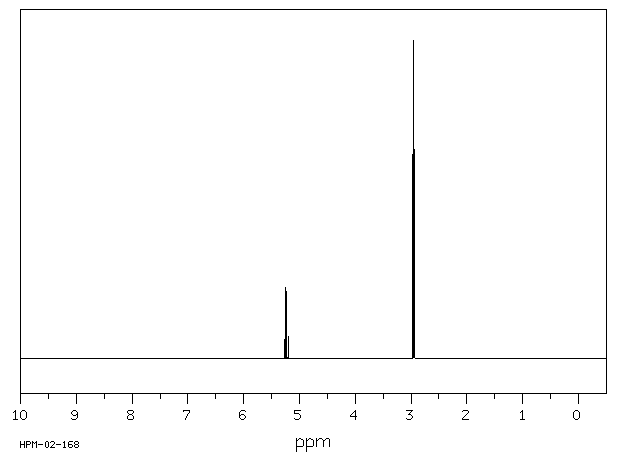1,1-二碘乙烷 | 594-02-5
中文名称
1,1-二碘乙烷
中文别名
——
英文名称
1,1-diiodoethane
英文别名
diiodoethane
CAS
594-02-5
化学式
C2H4I2
mdl
——
分子量
281.863
InChiKey
JNVXRQOSRUDXDY-UHFFFAOYSA-N
BEILSTEIN
——
EINECS
——
-
物化性质
-
计算性质
-
ADMET
-
安全信息
-
SDS
-
制备方法与用途
-
上下游信息
-
文献信息
-
表征谱图
-
同类化合物
-
相关功能分类
-
相关结构分类
物化性质
-
熔点:63.01°C (estimate)
-
沸点:223.38°C (estimate)
-
密度:2.7600
计算性质
-
辛醇/水分配系数(LogP):2.5
-
重原子数:4
-
可旋转键数:0
-
环数:0.0
-
sp3杂化的碳原子比例:1.0
-
拓扑面积:0
-
氢给体数:0
-
氢受体数:0
安全信息
-
海关编码:2903399090
SDS
模块 1. 化学品
1.1 产品标识符
: 1,1-Diiodoethane
产品名称
1.2 鉴别的其他方法
Ethylidene iodide
1.3 有关的确定了的物质或混合物的用途和建议不适合的用途
仅用于研发。不作为药品、家庭或其它用途。
模块 2. 危险性概述
2.1 GHS-分类
急性毒性, 经口 (类别 4)
皮肤刺激 (类别 2)
眼睛刺激 (类别 2A)
特异性靶器官系统毒性(一次接触) (类别 3), 呼吸系统
2.2 GHS 标记要素,包括预防性的陈述
象形图
警示词 警告
危险申明
H302 吞咽有害。
H315 造成皮肤刺激。
H319 造成严重眼刺激。
H335 可能引起呼吸道刺激。
警告申明
预防措施
P261 避免吸入粉尘/烟/气体/烟雾/蒸气/喷雾.
P264 操作后彻底清洁皮肤。
P270 使用本产品时不要进食、饮水或吸烟。
P271 只能在室外或通风良好之处使用。
P280 戴护目镜/戴面罩。
P280 戴防护手套。
事故响应
P301 + P312 如果吞咽并觉不适: 立即呼叫解毒中心或就医。
P302 + P352 如接触皮肤:使用大量水冲洗。
P304 + P340 如果吸入:将受害人移至空气新鲜处并保持呼吸舒适的姿势休息。
P305 + P351 + P338 如与眼睛接触,用水缓慢温和地冲洗几分钟。如戴隐形眼镜并可方便地取
出,取出隐形眼镜,然后继续冲洗.
P312 如感觉不适,呼救中毒控制中心或医生.
P321 具体处置(见本标签上提供的急救指导)。
P330 漱口。
P332 + P313 如觉皮肤刺激:求医/就诊。
P337 + P313 如仍觉眼睛刺激:求医/就诊。
P362 + P364 脱掉玷污的衣服,清洗后方可再用。
安全储存
P403 + P233 存放于通风良的地方。 保持容器密闭。
P405 存放处须加锁。
废弃处置
P501 将内容物/ 容器处理到得到批准的废物处理厂。
2.3 其它危害物 - 无
模块 3. 成分/组成信息
3.1 物 质
: Ethylidene iodide
别名
: C2H4I2
分子式
: 281.86 g/mol
分子量
组分 浓度或浓度范围
1,1-Diiodoethane
<=100%
化学文摘登记号(CAS 594-02-5
No.) 209-821-0
EC-编号
模块 4. 急救措施
4.1 必要的急救措施描述
一般的建议
请教医生。 向到现场的医生出示此安全技术说明书。
吸入
如果吸入,请将患者移到新鲜空气处。 如呼吸停止,进行人工呼吸。 请教医生。
皮肤接触
用肥皂和大量的水冲洗。 请教医生。
眼睛接触
用大量水彻底冲洗至少15分钟并请教医生。
食入
切勿给失去知觉者通过口喂任何东西。 用水漱口。 请教医生。
4.2 主要症状和影响,急性和迟发效应
据我们所知,此化学,物理和毒性性质尚未经完整的研究。
4.3 及时的医疗处理和所需的特殊处理的说明和指示
无数据资料
模块 5. 消防措施
5.1 灭火介质
灭火方法及灭火剂
用水雾,抗乙醇泡沫,干粉或二氧化碳灭火。
5.2 源于此物质或混合物的特别的危害
碳氧化物, 碘化氢
5.3 给消防员的建议
如必要的话,戴自给式呼吸器去救火。
5.4 进一步信息
无数据资料
模块 6. 泄露应急处理
6.1 作业人员防护措施、防护装备和应急处置程序
使用个人防护用品。 避免吸入蒸气、烟雾或气体。 保证充分的通风。 人员疏散到安全区域。
6.2 环境保护措施
不要让产品进入下水道。
6.3 泄漏化学品的收容、清除方法及所使用的处置材料
用惰性吸附材料吸收并当作危险废物处理。 放入合适的封闭的容器中待处理。
6.4 参考其他部分
丢弃处理请参阅第13节。
模块 7. 操作处置与储存
7.1 安全操作的注意事项
避免接触皮肤和眼睛。 避免吸入蒸气和烟雾。
7.2 安全储存的条件,包括任何不兼容性
贮存在阴凉处。 使容器保持密闭,储存在干燥通风处。
打开了的容器必须仔细重新封口并保持竖放位置以防止泄漏。
建议的贮存温度: -20 °C
对光线敏感
7.3 特定用途
无数据资料
模块 8. 接触控制和个体防护
8.1 容许浓度
最高容许浓度
没有已知的国家规定的暴露极限。
8.2 暴露控制
适当的技术控制
根据良好的工业卫生和安全规范进行操作。 休息前和工作结束时洗手。
个体防护设备
眼/面保护
面罩與安全眼鏡请使用经官方标准如NIOSH (美国) 或 EN 166(欧盟) 检测与批准的设备防护眼部。
皮肤保护
戴手套取 手套在使用前必须受检查。
请使用合适的方法脱除手套(不要接触手套外部表面),避免任何皮肤部位接触此产品.
使用后请将被污染过的手套根据相关法律法规和有效的实验室规章程序谨慎处理. 请清洗并吹干双手
所选择的保护手套必须符合EU的89/686/EEC规定和从它衍生出来的EN 376标准。
身体保护
全套防化学试剂工作服, 防护设备的类型必须根据特定工作场所中的危险物的浓度和数量来选择。
呼吸系统防护
如危险性评测显示需要使用空气净化的防毒面具,请使用全面罩式多功能防毒面具(US)或ABEK型
(EN
14387)防毒面具筒作为工程控制的候补。如果防毒面具是保护的唯一方式,则使用全面罩式送风防
毒面具。 呼吸器使用经过测试并通过政府标准如NIOSH(US)或CEN(EU)的呼吸器和零件。
模块 9. 理化特性
9.1 基本的理化特性的信息
a) 外观与性状
形状: 透明, 液体
颜色: 深黄
b) 气味
无数据资料
c) 气味阈值
无数据资料
d) pH值
无数据资料
e) 熔点/凝固点
熔点/凝固点: -60 °C - lit.
f) 沸点、初沸点和沸程
61 °C177 - 179 °C - lit.
g) 闪点
无数据资料
h) 蒸发速率
无数据资料
i) 易燃性(固体,气体)
无数据资料
j) 高的/低的燃烧性或爆炸性限度 无数据资料
k) 蒸气压
无数据资料
l) 蒸汽密度
无数据资料
m) 密度/相对密度
2.794 g/cm3
n) 水溶性
无数据资料
o) n-辛醇/水分配系数
无数据资料
p) 自燃温度
无数据资料
q) 分解温度
无数据资料
r) 粘度
无数据资料
模块 10. 稳定性和反应活性
10.1 反应性
无数据资料
10.2 稳定性
无数据资料
10.3 危险反应
无数据资料
10.4 应避免的条件
无数据资料
10.5 不相容的物质
强碱, 强氧化剂
10.6 危险的分解产物
其它分解产物 - 无数据资料
模块 11. 毒理学资料
11.1 毒理学影响的信息
急性毒性
无数据资料
皮肤刺激或腐蚀
无数据资料
眼睛刺激或腐蚀
无数据资料
呼吸道或皮肤过敏
无数据资料
生殖细胞致突变性
无数据资料
致癌性
IARC:
此产品中没有大于或等于 0。1%含量的组分被 IARC鉴别为可能的或肯定的人类致癌物。
生殖毒性
无数据资料
特异性靶器官系统毒性(一次接触)
无数据资料
特异性靶器官系统毒性(反复接触)
无数据资料
吸入危险
无数据资料
潜在的健康影响
吸入 吸入可能有害。 引起呼吸道刺激。
摄入 误吞对人体有害。
皮肤 通过皮肤吸收可能有害。 造成皮肤刺激。
眼睛 造成严重眼刺激。
接触后的征兆和症状
据我们所知,此化学,物理和毒性性质尚未经完整的研究。
附加说明
化学物质毒性作用登记: 无数据资料
模块 12. 生态学资料
12.1 生态毒性
无数据资料
12.2 持久性和降解性
无数据资料
12.3 潜在的生物累积性
无数据资料
12.4 土壤中的迁移性
无数据资料
12.5 PBT 和 vPvB的结果评价
无数据资料
12.6 其它不良影响
无数据资料
模块 13. 废弃处置
13.1 废物处理方法
产品
将剩余的和不可回收的溶液交给有许可证的公司处理。
受污染的容器和包装
按未用产品处置。
模块 14. 运输信息
14.1 联合国危险货物编号
欧洲陆运危规: - 国际海运危规: - 国际空运危规: -
14.2 联合国运输名称
欧洲陆运危规: 非危险货物
国际海运危规: 非危险货物
国际空运危规: 非危险货物
14.3 运输危险类别
欧洲陆运危规: - 国际海运危规: - 国际空运危规: -
14.4 包裹组
欧洲陆运危规: - 国际海运危规: - 国际空运危规: -
14.5 环境危险
欧洲陆运危规: 否 国际海运危规 国际空运危规: 否
海洋污染物(是/否): 否
14.6 对使用者的特别提醒
无数据资料
参见发票或包装条的反面。
模块 15 - 法规信息
N/A
模块16 - 其他信息
N/A
上下游信息
-
上游原料
中文名称 英文名称 CAS号 化学式 分子量 碘乙烷 ethyl iodide 75-03-6 C2H5I 155.966
反应信息
-
作为反应物:描述:参考文献:名称:Gustavson, Chemische Berichte, 1874, vol. 7, p. 731摘要:DOI:
-
作为产物:参考文献:名称:用于高选择性环氧醇环化的二恶烷模板摘要:梯形聚醚天然产物是一类具有高官能团密度和大量明确立体中心的天然产物。它们包含有害藻华 (HAB) 的有毒成分,具有显着的负面经济和环境影响。然而,它们的作用方式,即阻断各种细胞离子通道,也表明它们有望成为潜在的抗癌剂。了解它们潜在的生物合成模式不仅有助于开发限制 HAB 损害的方法,而且还有助于合成一系列具有有趣生物活性的类似物。1,3-二恶烷-5-醇底物在合成这些梯形聚醚天然产物的过程中,在水促进的环氧化物环化过程中显示出显着的“增强的模板效应”。在很多情况下,内-到-外切在环氧基醇的环化的选择性,从而有利于强烈四氢吡喃(THP)在四氢呋喃(THF)的环的形成。探索了各种 Brønsted 和 Lewis 酸性和碱性条件的影响,以证明与先前报道的基于 THP 的环氧醇相比,模板具有更高的选择性。此外,还考虑考虑其他合成路线,目的是快速获得大量适用于合成梯形聚醚的潜在原料。最后,研究了多环DOI:10.1002/chem.201300845
-
作为试剂:参考文献:名称:杂金属在有机合成中的一些用途摘要:Mischmetall是一种轻型镧系元素的合金,已用于多种有机反应中,作为sa(II)介导的反应(巴比尔和格利雅德型反应,松香偶联反应)的共轭物或Reformatsky-的促进剂。类型反应。它也被用作容易合成镧系三卤化物的起始原料,在今元和Luche-Fukuzawa反应以及Mukaiyama aldol反应中已经探究了其反应活性。DOI:10.1016/j.tet.2003.07.017
文献信息
-
Synthesis of (?)-Pinidinevia asymmetric, electrophilic enolate hydroxyamination/nitrone reduction作者:Wolfgang Oppolzer、Eric MerifieldDOI:10.1002/hlca.19930760218日期:1993.3.24Enantiomerically pure(−)-pinidine (1) has been synthesized in 18.5% overall yield by a nine-step sequence starting from keto-ester 2. The key step 5 6 involves an asymmetric, electrophilic enolate hydroxyamination. Diastereoselective hydrogenation of nirtone 6 ensures the cis-relation between the substituents at C(2) and C(6) in piperidine 7.
-
Herbicides
-
A Simple Zinc-Mediated Preparation of Selenols作者:Claudio Santi、Stefano Santoro、Lorenzo Testaferri、Marcello TieccoDOI:10.1055/s-2008-1078408日期:2008.6Under acidic conditions zinc reduces diselenides to afford selenols, which can be either isolated or treated in situ with alkyl halides to produce alkyl selenides or with epoxides to give β-hydroxyselenides.
-
Cyclofunctionalisation of epoxyalcohol derivatives. 4. Cyclisation of sulfonylacetate dianions: A synthesis of “MeBMT”作者:Stuart W. McCombie、Bandarpalle B. Shankar、Ashit K. GangulyDOI:10.1016/s0040-4039(01)93415-x日期:——α,α-Dianions, derived from arenesulfonylacetate esters of 2,3-epoxyalcohols, cyclised to give 3-arenesulfonyl-4-(1-hydroxyalkyl)-γ-butyrolactones. Dianion fragmentation to regenerate the epoxyalcohol was a competing, substrate-dependent process. Sulfonyllactone (9) was elaborated efficiently to an advanced intermediate for the unusual aminoacid “MeBMT” (5), and also to stereodefined cyclopropane derivatives
-
The Total Synthesis of Corallopyronin A and Myxopyronin B作者:Andreas Rentsch、Markus KalesseDOI:10.1002/anie.201206560日期:2012.11.5Leading the way: The synthesis of natural products with new biological targets is one of the driving forces for the development of new antibiotics. The synthesis of the two secondary metabolites corallopyronin and myxopyronin (see picture) have been achieved, which are prominent leads for the inhibition of bacterial RNA polymerase.
表征谱图
-
氢谱1HNMR
-
质谱MS
-
碳谱13CNMR
-
红外IR
-
拉曼Raman
-
峰位数据
-
峰位匹配
-
表征信息
同类化合物
胍,N-[3-(氨基甲基)-5-甲基苯基]-N'-乙基-
碘甲烷
碘甲基环辛烷
碘甲基环戊烷
碘环庚烷
碘环十二烷
碘环丁烷
碘十六烷
碘代环戊烷
碘代正辛烷-D2
碘代异丁烷
碘代叔丁烷
碘代丙烷-D7
碘代丙烷-D3
碘代丙烷-D2
碘代丙烷-D2
碘乙烷-d<
碘乙烷-D1
碘乙烷-2-13C
碘乙烷-2,2,2-d3
碘乙烷-1-13C
碘乙烷-1,1-d2
碘乙烷(1,2-13C2)
碘乙烷
碘丁烷-D9
碘(碘甲氧基)甲烷
甲基碘化钙
环辛烷,1-氟-2-碘-,反-
环戊二烯并[1,3]环丙烯并[1,2]环庚烯-2(1H)-酮,八氢-3a,5,5-三甲基-,(3aR,3bR,8aS)-rel-
环丙基碘
无花果蛋白酶来源于无花果树乳胶
新戊氧基
新戊基碘
抗-8-碘-1,5-二甲基二环<3.2.1>辛烷
抗-8-碘-1,5-二甲基二环<3.2.1>辛烷
异戊基碘
异丁基锰(II)碘化物
反式-4-己烯基碘
十氢-2-(碘甲基)-萘
十四烷基碘化物
十五氟碘庚烷
十九氟-9-碘壬烷
全氟辛基碘烷
全氟碘代丁烷
全氟异戊基碘
全氟异庚基碘化物
全氟异壬基碘
全氟异十一烷基碘化物
全氟己基碘烷
全氟叔丁基碘化物







